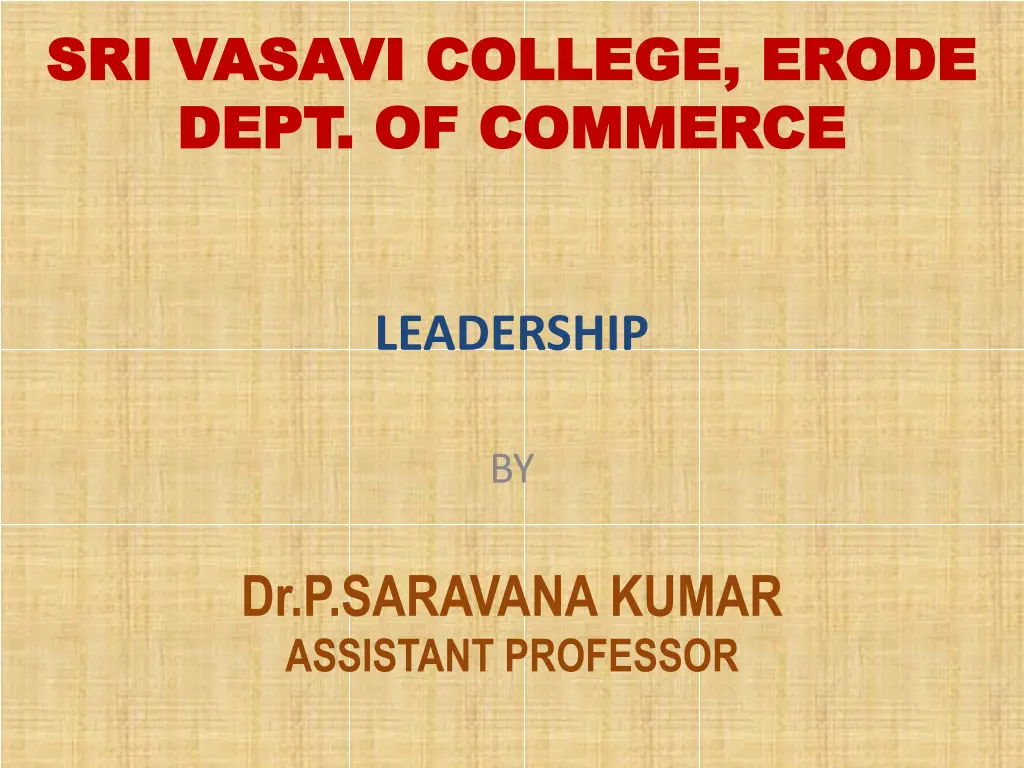
Leadership in Commerce: Advantages, Disadvantages, and Styles
Explore the meaning, advantages, disadvantages, and various styles of leadership in commerce. Understand how effective leadership influences job satisfaction, teamwork, decision-making, and more within an organization.
Download Presentation

Please find below an Image/Link to download the presentation.
The content on the website is provided AS IS for your information and personal use only. It may not be sold, licensed, or shared on other websites without obtaining consent from the author. If you encounter any issues during the download, it is possible that the publisher has removed the file from their server.
You are allowed to download the files provided on this website for personal or commercial use, subject to the condition that they are used lawfully. All files are the property of their respective owners.
The content on the website is provided AS IS for your information and personal use only. It may not be sold, licensed, or shared on other websites without obtaining consent from the author.
E N D
Presentation Transcript
SRI VASAVI COLLEGE, ERODE SRI VASAVI COLLEGE, ERODE DEPT. OF COMMERCE DEPT. OF COMMERCE LEADERSHIP BY Dr.P.SARAVANA KUMAR ASSISTANT PROFESSOR
MEANING & DEFINITION Leadership is the ability of an individual or a group of individuals to influence and guide followers or other members of an organization. George R. Terry, Leadership is a relationship in which one person influences others to work together willingly on related tasks to attain what the leader desires. Koontz and O'Donnell, Leadership is the process of influencing people so that they will strive willingly towards the achievement of group goals.
ADVANTAGES OF LEADERSHIP Improves Job satisfaction Improve customer service Improves teamwork at work place Improves communication and listening skills Improves productivity and performance Improves decision making skills Increases self confidence in a team Improves quality within an organization Enhancing employee effectiveness Improves functional efficiency Good leadership improves patient care Increases motivation in a group
DISADVANTAGES OF LEADERSHIP 1. Slower decision making 2. Workers may feel demotivated 3. May not appropriate if decision need to make quickly 4. Leadership may not suit all workers 5. Mental and physical stress in organization 6. Leaders only make the decision 7. Employee lack of freedom
STYLES OF LEADERSHIP Different styles of leadership, but we will focus on 7 of the most common here. Transactional leadership responsibilities by using incentivization to motivate employees. Transformational leadership - a popular style among growth-oriented companies employees to see what they are capable of. Servant leadership - The servant leadership style can be a very effective model for empowering teams and boosting morale. Servant style leadership means prioritizing the needs of your team above all else. - establish roles and as it encourages
Democratic leadership - an extremely effective leadership style because it empowers team members at all levels to feel organization. Autocratic leadership - the leader makes decisions without taking input from any stakeholders. Bureaucratic leadership - style might consider the input of team members. However, if that input conflicts with existing policy the leader will likely reject it. Laissez-Faire leadership -laissez-Faire leadership style is often found in younger start-ups. In this leadership style, leaders put nearly all the decision making power in the hands of their employees. empowered within the
LEADERSHIP QUALITIES 7 Important Leadership Qualities Willingness to Listen. Perseverance. Honesty. ... Selflessness. ... Decisiveness. ... Trust. ... Integrity.
MBO MANAGEMENT BY OBJECTIVES The idea of management by objectives (MBO), first outlined by Peter Drucker and then developed by George Odiorne, his student, was popular in the 1960s and 1970s. In his book The Practice of Management , published in 1954. MBO is the process of defining top company goals and using them to determine employees objectives. MBO processes are intended to identify an employee s main objectives, later graded with group input.
MBO PROCESS The MBO process consists of five steps: Set company objectives Cascade objectives to employees Monitor Evaluate performance Reward performance
ADVANTAGES &DISADVANTAGES OF MBO Advantages Disadvantages Difficult to succeed without support from top management Provides better clarity of objectives May not be popular with subordinates Improves efficiency Long term goals are given lower priority Increased morale Lack of necessary skills can impair MBO Risk is reduced Difficulty integrating with other systems Ensures accountability
MANAGEMENT BY EXCEPTION Management by exception is a leadership method that encourages employees to bring only the biggest issues to company supervisors to dedicate their effort and attention to the most important tasks. Management professionals invest most of their time in effort in establishing new policies and making company decisions rather than being involved in the daily activity of the company. management, allowing
Management by exception functions by following these steps: 1. Set a standard for normal operations 2. Establishing a hierarchy 3. Assessing employee performance 4. Investigating and solving exceptions
PROS OF MANAGEMENT BY EXCEPTION Efficient practices Sets clear priorities Motivates employees Quickly addresses problems
CONS OF MANAGEMENT BY EXCEPTION Less preventive Requires close monitoring Advanced problem-solving
